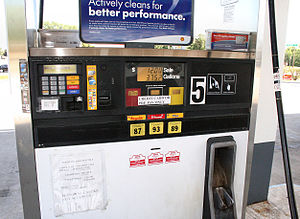 Image via WikipediaIt is not new news to anybody that drives that gasoline prices are soaring. As we speak, prices seem to increase on a daily basis and are rapidly approaching the record prices set a few years ago. The main difference being that the current president doesn't seem to catch the same flack from the media that the former president did when prices rose three years ago.
Image via WikipediaIt is not new news to anybody that drives that gasoline prices are soaring. As we speak, prices seem to increase on a daily basis and are rapidly approaching the record prices set a few years ago. The main difference being that the current president doesn't seem to catch the same flack from the media that the former president did when prices rose three years ago.One of the blogs that I like to visit is The Matthias Chronicles, written by Mar Matthias Darin. His most recent post is a very thorough examination of how the monetary policies of Barack Obama and Fed Chairman Ben Bernanke have played a large part in the soaring price of filling our tanks. He is right on the money on that aspect, but there are other contributing factors, some that can be blamed on policies of the current administration.
First and foremost is the administration's stand on drilling for domestic oil resources. With all of the restrictions placed on domestic drilling, we are producing much less oil than we are capable of doing. In 2008, our demand for oil declined dramatically with the soaring costs. As our economy has slowly improved, our demand for oil has started to increase again, but we are producing less oil than we were three years ago. Higher demand + lower supply=higher costs.
Two other big factors contributing to the soaring gas prices are the demand for oil in growing economies like China and decisions made by OPEC. Chinese demand for oil has been growing at a double digit rate for the past few years and is expected to continue to rise. OPEC recently cut their production rates. Again, higher demand + lower supply=higher costs.
Yesterday, I was listening to a radio program hosted by noted economist Peter Morici of my alma mater, the University of Maryland. One of his guests yesterday was former president of Shell, John Hofmeister. Hofmeister testified before Congress earlier this year and said if the US were to set a goal to raise production from the 7 million barrels per day to 10 million barrels per day it would create 3 million new jobs. With millions out of work, I guess the current administration doesn't really want policies to create jobs.
Now, back to the title of my post. In year's past, I have never been one to shop around for gasoline prices. I pretty much stopped at my normal stops and would fill up as needed. I never really went out of my way to find the lowest gas prices in town. I never thought it very practical to drive around to save a couple pennies per gallon for gas. Now those days are gone.
I still pretty much know who has the lowest gasoline prices in my neighborhood. Right now that is usually BJ's Wholesale Club. There are a couple of places that are within a couple cents of BJ's that I will stop at if the line at BJ's is terribly long, which sometimes happens. For those times when I am not in my neighborhood, or if I don't want to hit BJ's, I have downloaded the Gas Buddy app on my phone. It is a great tool for finding the best gas prices nearby.
As of yesterday, the gas prices in my neighborhood were in the range of $3.78-$3.91 per gallon. I filled up my tank for a mere $3.51 per gallon. It is not that I was privy to some special insiders deal, but rather I took advantage of a program that my local Giant has with Shell gasoline. For every dollar I spend at Giant, I earn a point. For every 100 points I earn, I receive a 10 cent discount on Shell for gas. Since my Shell is a little out of the way and more expensive than BJ's, I usually wait until I have earned at least 300 points before taking advantage of the discount. If your grocer has a loyalty program that has gas rewards, you need to take advantage of it.
I mentioned Peter Morici and his radio show earlier in this post. One of the things that Morici detailed on the show was what makes up the price of a gallon of gas. Most of it is the cost of crude oil, and then there is another dollar or so in taxes and refining costs. The gas station that you buy your gas from usually only makes a dime or so in profit on the price at the pump. Since so many of us pay at the pump with our debit or credit cards, the gas retailer takes another hit from fees charged by the banks issuing those cards. There are a lot of stations, that give an additional discount for customers paying with cash. That is another opportunity to save a few cents per gallon.

Excellent Article! I may not know what I am talking about (again), but I look upon the exorbitant pump prices as being nothing more than corporate greed. For gas prices did not go down to even close to what they were before the crude oil shortage a few years back when we supposedly had plenty to work with, and now they are just adding more to their profits, which happily go along with as a nation.
ReplyDelete